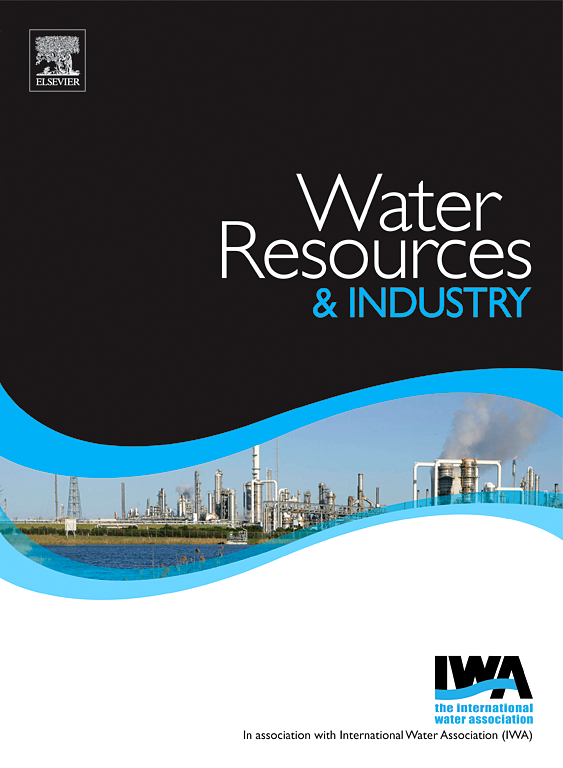Polyphosphate salt and organic acid in deliming to reduce nitrogenous compounds in tannery wastewater
IF 7.5
3区 工程技术
Q1 WATER RESOURCES
引用次数: 0
Abstract
Deliming is a process in leather manufacturing to remove lime from the limed pelt. In conventional deliming, nitrogenous pollutants (ammonia-nitrogen, NH3-N, and Total Kjeldahl Nitrogen, TKN) are released, creating unfavorable conditions for aquatic life. In this study, a combination of pyruvic acid (PA) and polyphosphate salt (PPS) is used in deliming instead of ammonium sulfate to reduce NH3-N and TKN in tannery wastewater. Results revealed that deliming with PA (0.5 %) + PPS (1.0 %) for 90 min showed superior reduction of TKN (86.68 %), NH3-N (97.56 %), electrical conductivity (57.68 %), salinity (66.73 %), total dissolved solids (63.3 %), chemical oxygen demand (83.61 %), and biochemical oxygen demand (15.9 %) in the discharged wastewater. The hydroxyproline released in the experimental deliming (PA + PPS) wastewater was much lower than that of the conventional technique. The combination of PA + PPS deliming agent removed calcium to an acceptable level of chelation. The physical and organoleptic properties, shrinkage temperature, and thickness variation were comparable to the standard requirements. SEM photographs of delimed pelt and crust leather illustrated a similar fiber orientation, whereas the Pseudo-Second-Order (PSO) kinetics revealed an impressive reaction for the deliming effect compared to Pseudo-First-Order (PFO). Hence, this study provided a new pathway in leather making to reduce pollution, maintaining an environmentally friendly approach.

聚磷酸盐和有机酸在制革废水中减少含氮化合物的作用
划边是皮革制造过程中去除石灰皮上的石灰的过程。在常规划界中,氮污染物(氨氮,NH3-N,总凯氏定氮,TKN)被释放,对水生生物造成不利条件。本研究以丙酮酸(PA)和聚磷酸盐(PPS)的组合代替硫酸铵进行定界,以降低制革废水中的NH3-N和TKN。结果表明,用PA (0.5%) + PPS(1.0%)划水90 min,对废水中总氮(TKN)(86.68%)、氨氮(97.56%)、电导率(57.68%)、盐度(66.73%)、总溶解固形物(63.3%)、化学需氧量(83.61%)和生化需氧量(15.9%)均有较好的降低效果。实验定界(PA + PPS)废水中羟基脯氨酸的释放量远低于常规工艺。PA + PPS定界剂的组合将钙去除到可接受的螯合水平。物理和感官性能、收缩温度和厚度变化符合标准要求。分隔皮和皮皮的SEM照片显示了类似的纤维取向,而伪二阶(PSO)动力学显示了与伪一阶(PFO)相比令人印象深刻的分隔效应反应。因此,本研究为皮革制造提供了一条减少污染,保持环境友好的新途径。
本文章由计算机程序翻译,如有差异,请以英文原文为准。
求助全文
约1分钟内获得全文
求助全文
来源期刊

Water Resources and Industry
Social Sciences-Geography, Planning and Development
CiteScore
8.10
自引率
5.90%
发文量
23
审稿时长
75 days
期刊介绍:
Water Resources and Industry moves research to innovation by focusing on the role industry plays in the exploitation, management and treatment of water resources. Different industries use radically different water resources in their production processes, while they produce, treat and dispose a wide variety of wastewater qualities. Depending on the geographical location of the facilities, the impact on the local resources will vary, pre-empting the applicability of one single approach. The aims and scope of the journal include: -Industrial water footprint assessment - an evaluation of tools and methodologies -What constitutes good corporate governance and policy and how to evaluate water-related risk -What constitutes good stakeholder collaboration and engagement -New technologies enabling companies to better manage water resources -Integration of water and energy and of water treatment and production processes in industry
 求助内容:
求助内容: 应助结果提醒方式:
应助结果提醒方式:


